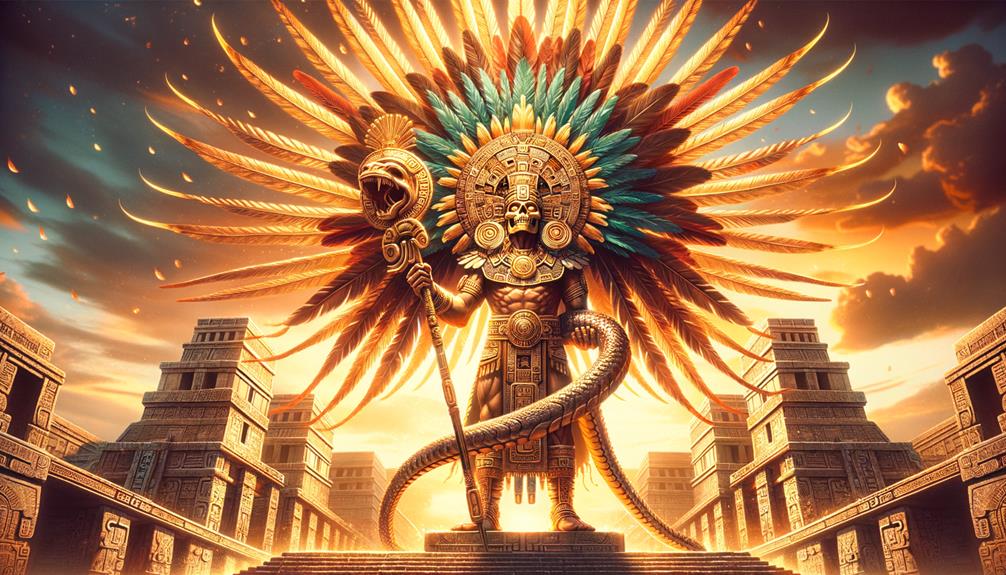Huitzilopochtli, the Aztec Sun God, embodied contrasts – the nurturing radiance of daylight fused with an unwavering warrior spirit. His name, 'hummingbird on the left,' hints at agility and territorial might. This deity guided the Aztecs to Tenochtitlan, and his shrines displayed symbols of power, underscoring his significance. Rituals, sometimes involving sacrifices, ensured the sun's rise and military triumphs, intertwining Huitzilopochtli with the cycle of life and death. These practices carry deeper cultural meanings worth exploring.
Etymology and Names
Huitzilopochtli's name blends 'hummingbird' and 'left' (or 'South') in Nahuatl, the Aztec language. This dual symbolism captures the deity's nurturing role as a sun god and fierce warrior spirit. For the Mexica people, he was a pivotal mythological figure woven into their spiritual and martial lives.
The hummingbird connection reveals Huitzilopochtli's agility and territorial nature, mirroring his warrior leadership. As the 'Hummingbird of the South,' he embodied the warmth and guidance associated with that cardinal direction, steering the Aztecs' endeavors.
Various names like Totec ('Our Lord') and Xiuhpilli ('Turquoise Prince') highlighted his authority, association with precious materials, and celestial realms. These monikers deepened the understanding of Huitzilopochtli's multifaceted persona within Aztec culture and cosmology.
Mythological Origins
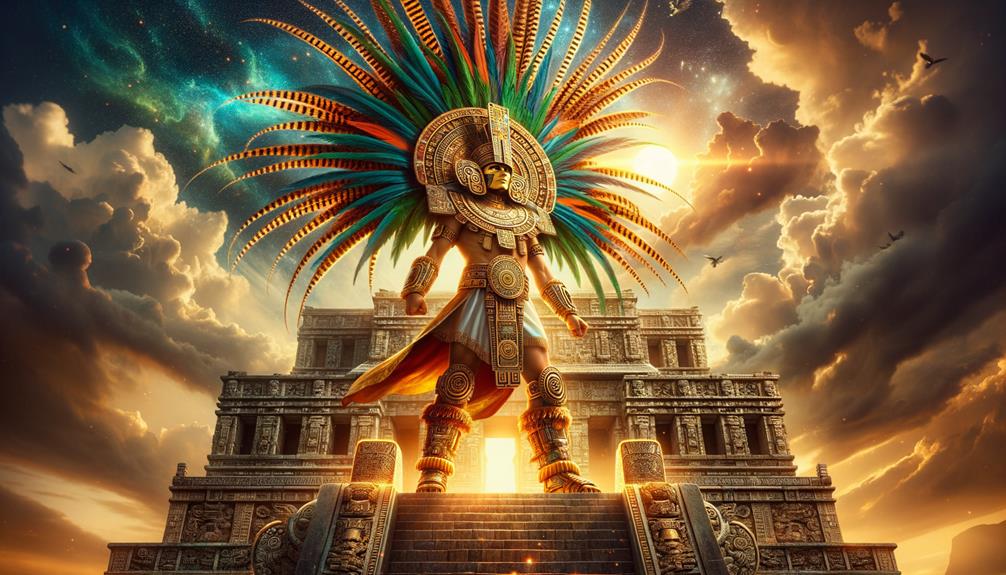
Huitzilopochtli's origin story combines celestial wonder and heroic destiny. As the Aztec Sun God, his birth marks a turning point for the people and their culture.
Coatlicue, the Earth mother goddess, conceived Huitzilopochtli from a ball of hummingbird feathers that descended from the heavens. This miraculous event set the stage for Huitzilopochtli's dramatic arrival on Coatepec (Snake Hill), fully armed to protect his mother from his vengeful siblings led by Coyolxauhqui. Huitzilopochtli triumphed, cementing his role as the god of war and the sun, bringing order from chaos.
| Symbol | Meaning |
|---|---|
| Hummingbird Feathers | Celestial origin |
| Snake Hill (Coatepec) | Place of transformation |
| Coyolxauhqui | Chaos and opposition |
| Huitzilopochtli | Order, war, and the sun |
This myth's symbolism reflects the Aztec emphasis on warfare and sacrifice, crucial for survival and spiritual beliefs. Huitzilopochtli inspired bravery and strength in Aztec warriors, solidifying his significance in their culture and religious practices across Mexico.
Role in Aztec Culture
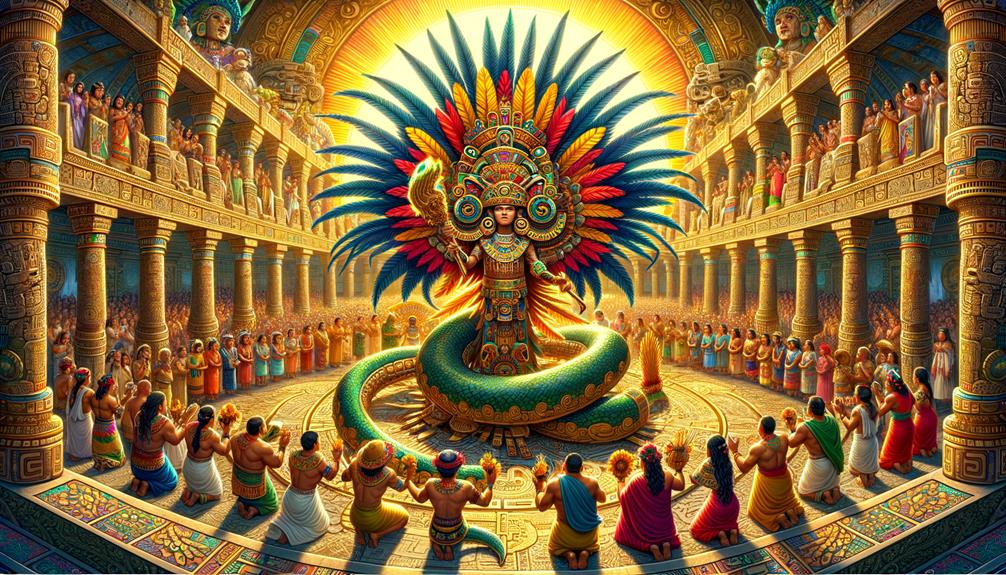
In the beating heart of Aztec society, Huitzilopochtli stood tall, personifying the courageous spirit of the people and their devotion to the sun and warfare. He wasn't just a god of war; he guided the Aztecs' legendary journey, culminating in the establishment of Tenochtitlan, their magnificent capital city nestled in the Valley of Mexico.
Human sacrifices fueled rituals honoring Huitzilopochtli, believed to ensure the sun's daily rise and victory in battle. The profound conviction in his power meant warriors' lifeblood nourished the sun, embodying the cycle of life and death woven into Aztec mythology.
Within Tenochtitlan, imposing temples dedicated to Huitzilopochtli adorned with symbols of his might rose into the sky. The vivid turquoise serpent encapsulated his dual nature as both nurturer and destroyer. Through these practices and icons, Huitzilopochtli's role became a heroic odyssey, an enduring battle to uphold cosmic balance and societal strength.
Iconography and Symbols
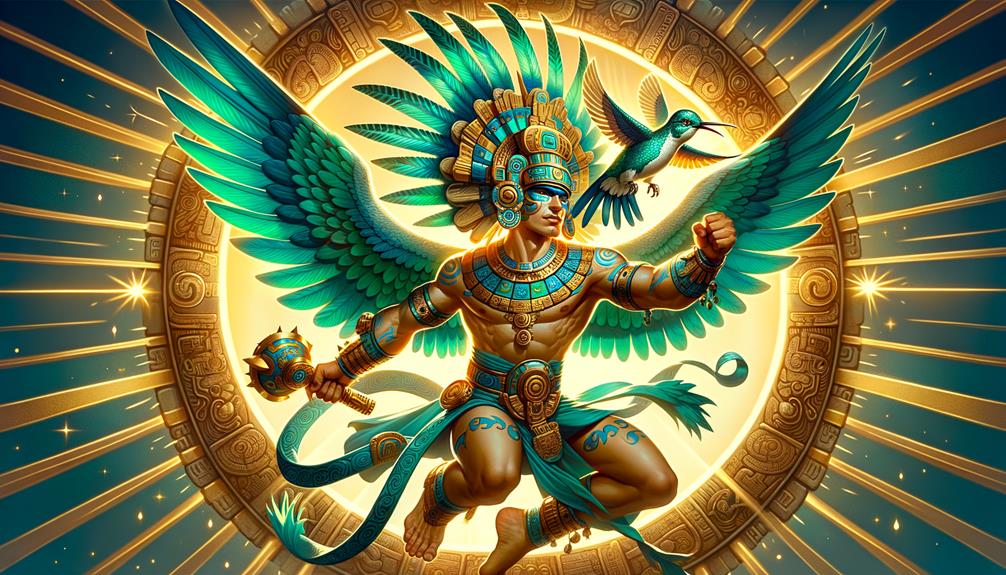
Huitzilopochtli's image captivates with vivid symbolism – the hummingbird personifying rebirth and the sun's ceaseless vigor, the eagle devouring a serpent embodying warfare dominion and protection. His blue and black face paint mirrors the sky and night, reflecting his dual role as sun and war deity. The shield and turquoise serpent showcase martial prowess and guardianship.
Feathered armor underscores his warrior status. These elements craft an awe-inspiring, symbolic portrait encapsulating Aztec cosmology's core. The god emerges as a compelling amalgamation of cyclical rejuvenation and relentless combat.
Huitzilopochtli's symbols speak volumes – the hummingbird evokes the sun's daily revival and the deity's own renewal. The eagle confronting the serpent signifies supremacy over war and guardianship roles. His visage, adorned in sky and night hues, captures his sun-war god duality. Accoutrements like the shield and serpent underscore martial might and protector aspects.
Feathered regalia reinforces the warrior identity. United, these motifs compose an impactful, symbolic rendering crystallizing central Aztec beliefs – Huitzilopochtli personifies the cycle of rebirth and unyielding battle prowess.
Sacrifices and Rituals
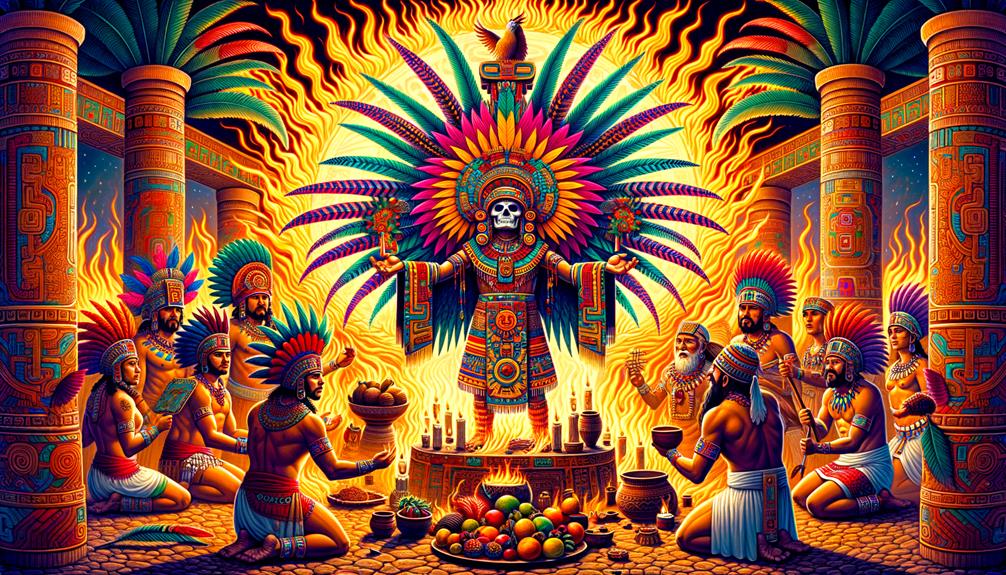
The beating heart of Aztec beliefs centered around appeasing Huitzilopochtli, their sun god. Human sacrifices played a pivotal role, seen as vital to prevent cosmic darkness and enable the sun's daily rise. These rituals forged an eternal bond between Aztec warriors and Huitzilopochtli, with the fallen believed to become one with the deity.
Central to this practice stood the Sun Stone, an intricate celestial calendar used to time ceremonies at auspicious moments. Lavish rites honoring Huitzilopochtli involved dances and ritual cleansings of prisoners or slaves destined for sacrifice – acts imbued with symbolism of warfare and sun worship.
To the Aztecs, these bloody offerings maintained cosmic equilibrium. Sacrifices fueled the sun's ceaseless journey across the sky, reflecting Huitzilopochtli's paramount importance in their culture and worldview. Through this brutal devotion, they strived to uphold the eternal cycle of light and darkness, rebirth and renewal.
Frequently Asked Questions
Was Huitzilopochtli the Sun God?
Huitzilopochtli embodied the eternal clash between day and night. His sacrifices represented the sun's daily triumph over darkness. As a heroic figure, he personified the cosmic struggle ensuring the sun rose victoriously each morning.
What Are Huitzilopochtli's Powers?
Huitzilopochtli played a pivotal role in Aztec culture, celebrated across 18 annual festivals. Revered as the sun's guardian, he symbolized life's cyclical nature of birth, death, and rebirth. Beyond solar guidance, Huitzilopochtli oversaw warfare and protected migrating peoples. This multifaceted deity embodied the eternal transition from one state to another.
What Aztec God Is the Sun?
Huitzilopochtli, the Aztec deity representing the sun, played a pivotal role in their culture. This god embodied the triumph over darkness, ushering in renewal and the life-sustaining energy of the solar rays. Huitzilopochtli guided the Aztec people through their symbolic hero's journey, reflecting their reverence for the sun as a vital force.
How Do You Pronounce the Name of the Aztec Sun God?
The Aztec sun god's name is pronounced "weet-zee-lee-poch-tlee." This reveals a sacred narrative weaving together the warrior hummingbird's symbolism of the south with grand mythological imagery and deep cultural significance.

